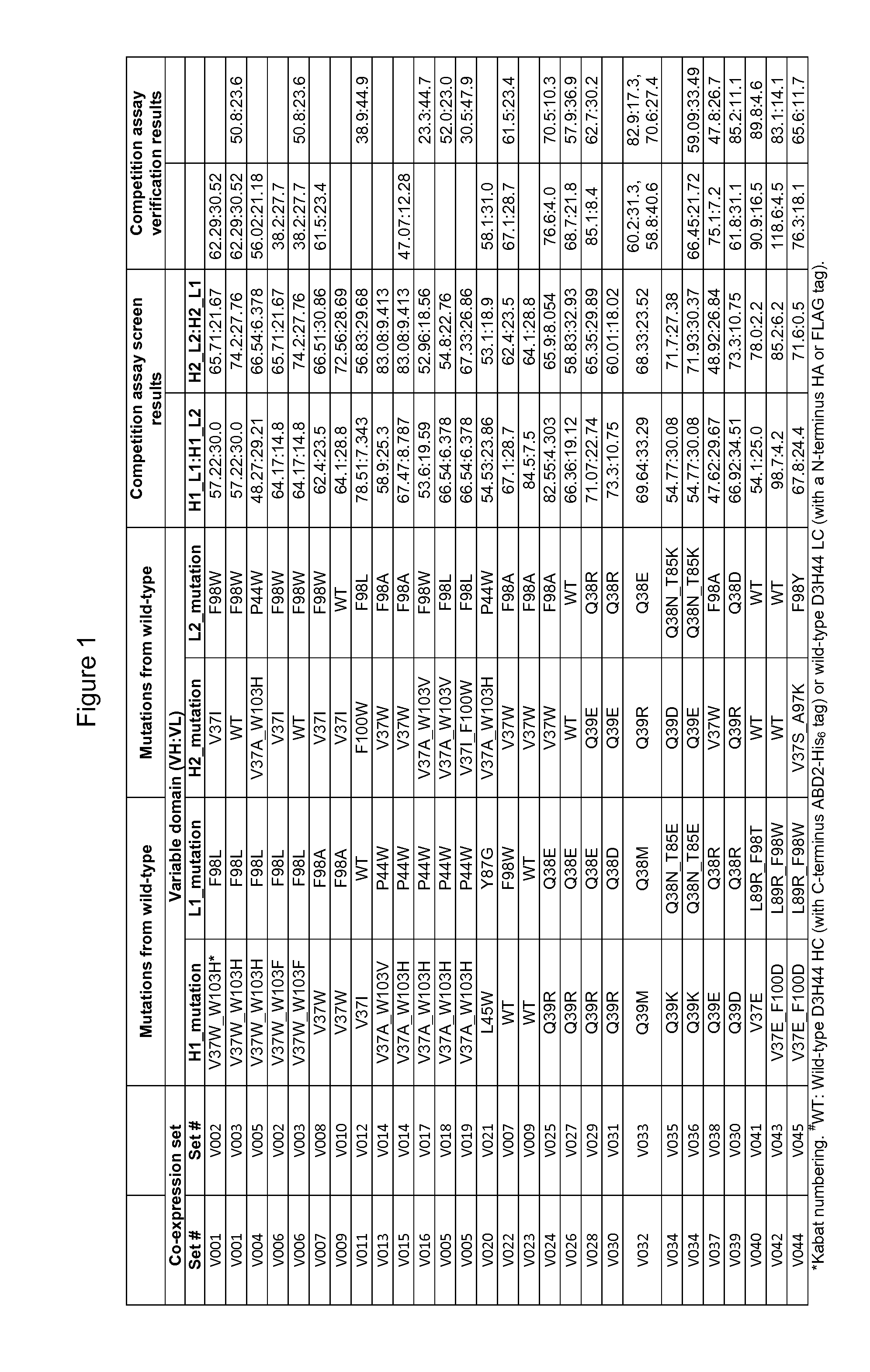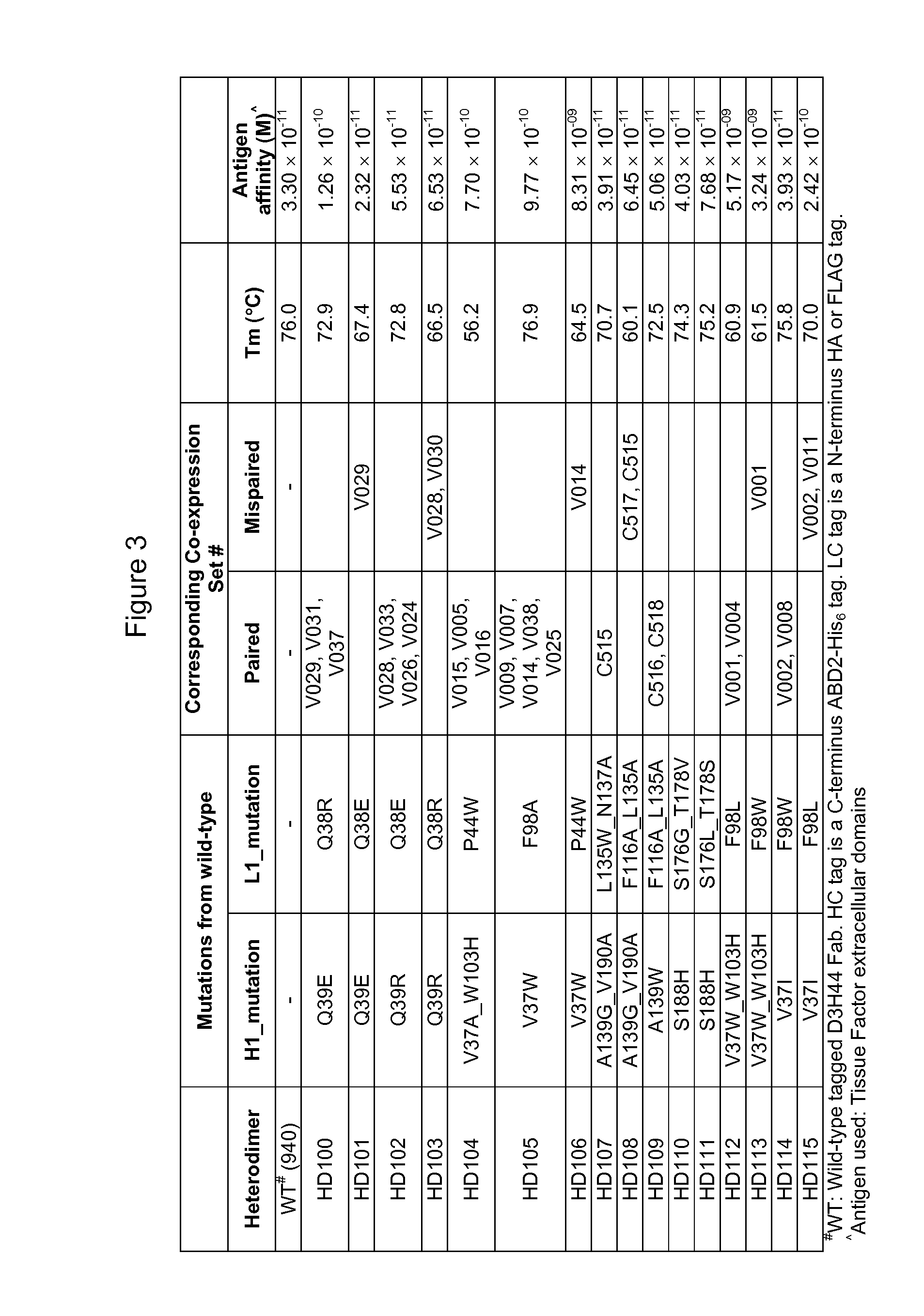Engineered Immunoglobulin Heavy Chain-Light Chain Pairs And Uses Thereof
a technology of immunoglobulin and light chain, applied in the field of bispecific antibodies, can solve problems such as the cracking of heavy chain-light chain pairings
- Summary
- Abstract
- Description
- Claims
- Application Information
AI Technical Summary
Benefits of technology
Problems solved by technology
Method used
Image
Examples
example 1
Preparation of Constructs Encoding D3H44 IgG Heavy Chains and D3H44 IgG Light Chains
[0172]The heavy and light chains of the anti-tissue factor antibody D3H44 for use in the co-expression sets described herein were prepared as follows. D3H44 Fab light (AJ308087.1) and heavy (AJ308086.1) chain sequences were taken from GenBank (www.ncbi.nlm.nih.gov / genbank / ), gene synthesized and codon optimized for mammalian expression. Light chain vector inserts, consisting of 5′-EcoRI cutsite—HLA-A signal peptide—HA or FLAG tag—Light chain clone—TGA stop—BamH1 cutsite-3′, were ligated into a pTT5 vector (Durocher Y et al., Nucl. Acids Res. 2002; 30, No. 2 e9). The resulting vector +insert were sequenced to confirm correct reading frame and sequence of the coding DNA. Likewise, heavy chain vector inserts, consisting of 5′-EcoR1cutsite—HLA-A signal peptide—heavy chain clone—ABD2-His6tag—TGA stop—BamH1 cutsite-3′, were ligated into a pTT5 vector (ABD; albumin binding domain). The resulting vector+inse...
example 2
Assessment of Preferential Pairing of Heterodimers in Co-Expression Sets Comprising Variable Domain Modifications in D3H44 IgG Light and / or Heavy Chains
[0173]The ability of heterodimers to preferentially pair in co-expression sets comprising D3H44 heavy and light chains with modified VL and / or VH domains was determined and the results are shown in FIG. 1. One D3H44 heavy chain construct was co-expressed with two unique D3H44 light chain constructs and the relative light chain pairing specificity (e.g. H1_L1:H1 _L2) was determined from a competition assay-SPR screen (Column entitled “Competition assay screen results” in FIG. 1). Selected heterodimer hits were confirmed via a modified competition assay verification where DNA ratios of L1:L2 were varied by 40:60, 50:50 and 60:40 during transfection (Column entitled “Competition assay verification results” in FIG. 1). Heavy chain (HC) was kept in limiting quantities (i.e. HC<L1+L2) for both competition assay screens and verifications. T...
example 3
Assessment of Preferential Pairing of Heterodimers in Co-Expression Sets Comprising Constant (CL or CH1) Domain Modifications in D3H44 IgG Light and / or Heavy Chains
[0182]The ability of heterodimers to preferentially pair in co-expression sets comprising D3H44 heavy and light chains with modified CL and / or CH1 domains was determined as described for heterodimers with variable domain modifications in Example 2, and the results are shown in FIG. 2. One D3H44 heavy chain construct was co-expressed with two unique D3H44 light chain constructs and the relative light chain pairing specificity (e.g. H1_L1:H1_L2) was determined from a competition assay-SPR screen (Column entitled “Competition assay screen results” in FIG. 2). Selected heterodimer hits were confirmed via a modified competition assay verification where DNA ratios of L1:L2 were varied by 40:60, 50:50 and 60:40 during transfection (Column entitled “Competition assay verification results” in FIG. 2). As described in Example 2, he...
PUM
| Property | Measurement | Unit |
|---|---|---|
| Temperature | aaaaa | aaaaa |
| Composition | aaaaa | aaaaa |
| Thermal stability | aaaaa | aaaaa |
Abstract
Description
Claims
Application Information
 Login to View More
Login to View More - R&D
- Intellectual Property
- Life Sciences
- Materials
- Tech Scout
- Unparalleled Data Quality
- Higher Quality Content
- 60% Fewer Hallucinations
Browse by: Latest US Patents, China's latest patents, Technical Efficacy Thesaurus, Application Domain, Technology Topic, Popular Technical Reports.
© 2025 PatSnap. All rights reserved.Legal|Privacy policy|Modern Slavery Act Transparency Statement|Sitemap|About US| Contact US: help@patsnap.com



